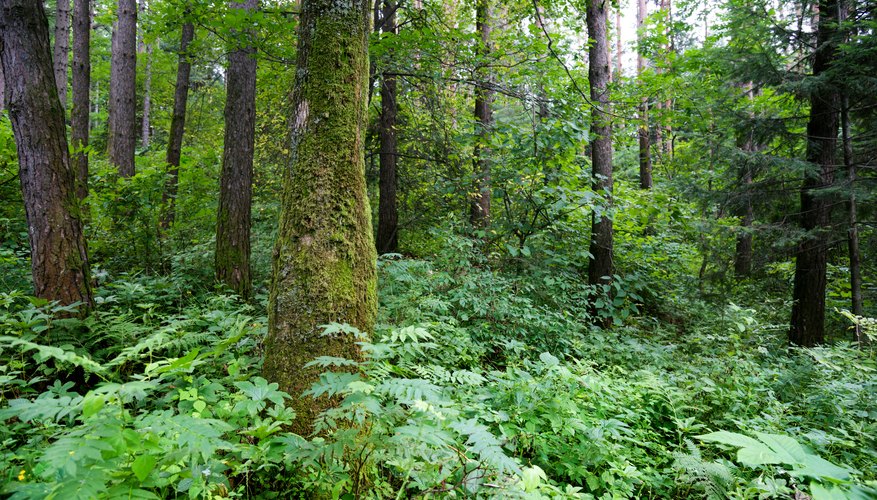Spiders are arachnid predators that are significant eaters in forest habitats. Spiders are a consumer since they do not produce their own food, and get food from dead organisms. They fill a void in the forest food web as adaptable and opportunistic generalist hunter. Spiders engage in active hunting and prey mostly on invertebrates, such as insects, other spiders, tiny crustaceans, and even small vertebrates like frogs and lizards. They track down their prey using their keen vision and quickness. Their hunting behavior influences the general structure and balance of the forest environment by regulating the population sizes of the prey species. As consumers spiders transfer energy and nutrients through the food web. They convert the biomass of their prey into their own body mass, thereby becoming a source of energy for other organisms that may prey upon them, such as larger spiders, birds, and small mammals. This energy transfer helps drive the flow of energy through the forest ecosystem, supporting the functioning and productivity of higher trophic levels.
Centipedes, as decomposers, play a vital role in the forest ecosystem by breaking down organic matter and aiding in the process of decomposition. Their niche within the forest lies in their ability to thrive in diverse microhabitats, such as leaf litter, soil, and rotting logs, where they scavenge on decaying plant material and other organic debris. By feeding on dead plant matter and detritus, centipedes contribute to nutrient cycling and the release of essential elements back into the soil, facilitating the recycling of organic matter and supporting the overall health and productivity of the forest ecosystem.

In the forest ecosystem, plants are the primary producers, using photosynthesis to transform inorganic elements like carbon dioxide and water into organic ones like sugars and carbohydrates. Their ability to gather sunlight, take up nutrients from the soil, and transform these resources into molecules rich in energy is what allows them to thrive in the forest. Based on elements including the availability of light, the kind of soil, the amount of moisture, and resource competition, they inhabit different niches. Different plant species have evolved to survive in particular habitats, such as the forest understory, forest floor, or canopy.
How are Decomposers, Producers, and Consumers affected by the spheres?
Geosphere
Decomposers: Decomposers, such as the centipede, convert organic matter, such decaying plants and animals, into simpler chemicals and restore the soil’s nutrition levels. Since decomposers rely on soil and other substrates for their activity, the lithosphere provides the ideal physical environment for them to flourish.

Producers: For anchoring and nutrient uptake, producers like plants and algae rely on the Geosphere. They take minerals and nutrients out of the soil to perform photosynthesis, which turns sunlight into molecules that are rich in energy.
Consumers: The Geosphere serves as a food source for consumers in the form of herbivores (plant eaters). To get nutrition and energy, they eat plants and algae.
Atmosphere
Decomposers: Fungi, although they don’t directly interact with the atmosphere, decomposers nonetheless have an indirect impact on it. As a consequence of decomposition, carbon dioxide (CO2) and other gases are released into the environment.

Producers: Producers, particularly plants, take part in the process of photosynthesis, which removes oxygen from the atmosphere and takes in carbon dioxide from the atmosphere. They support the regulation of atmospheric gas composition.
Consumers: Spiders, through respiration, consumers—including animals—take in oxygen from the atmosphere and use it to produce energy.
Hydrosphere
Decomposers: Organic matter in water bodies is broken down by aquatic decomposers like bacteria and fungi. They are essential to the decomposition of dead creatures and the recycling of nutrients in aquatic habitats.
The frog rely on the hydrosphere for water and nutrients, including phytoplankton and aquatic plants. They perform photosynthesis, giving aquatic habitats food and oxygen. It bounced around and used its mating call for reproduction.
&ehk=%2bTjSNYgaX64%2f3Xz%2fxWBzYIzzzHQygE7GVbIcW60RhPE%3d&risl=&pid=ImgRaw&r=0)
Consumers: The hydrosphere provides water to aquatic consumers like fish and aquatic mammals, who then rely on these plants and other species for food.
Biosphere
Decomposers: Because they disintegrate and reuse nutrients from dead organic matter, decomposers are an essential component of the biosphere. They aid in producers’ access to nutrients and support the health of ecosystems as a whole.

Producers: The ferns, by using photosynthesis to transform solar energy into organic compounds, producers form the backbone of the biosphere. They serve as the cornerstone of food chains and gave consumers food.
Consumers: The food chain of the biosphere is absolutely dependent on consumers, which include herbivores, carnivores, and omnivores. The bird by consuming other consumers and producers to gain energy, they control population dynamics and the flow of energy.
Food Chain:
Tertiary Consumer
.
.
.
Secondary Consumer

.
.
Primary Consumer
.
.
.
Producer

.
.
Rollie Pollie as Decomposer









